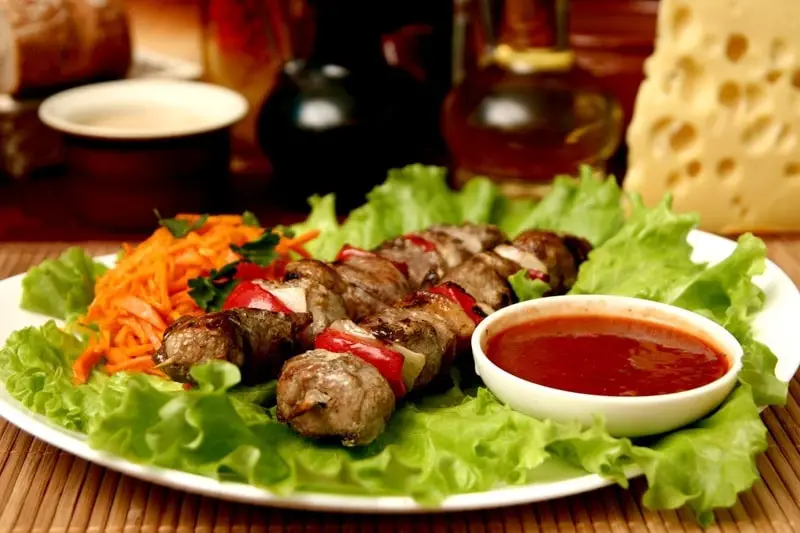Shashlyk (шашлык) is considered to be one of the very first dishes humans invented and most likely hails from the place the first modern human likely appeared – the area covering Iran, Iraq, Lebanon, and the Caucasus.
How “Shashlyk” Got Its Name
(Почему он так называется?)
The word “шашлык” was adopted into Russian in the 18th century. It may have come from Crimean Tartar. In that language “шыш” means “piece” and “шышлык” means “in pieces.”
However, it may also have come from Turkish where “шыш” is a skewer and “шышлык” is something on the skewer.
Interestingly, both languages are related to Persian, from where English adopted the phrase “shish kabab.” From Persian, this translates to “pieces of roasted meat.”
Shashlyk was eaten in Russia before the 18th century, but was most often called “верчёное мясо” which basically means “rotated meat” and was called so because it was usually roasted “на вертеле” (on a spit). Today, shashlyk is most often cooked on skewers, which Russians call “шампуры.”
There is evidence to suggest that “шампур” is related to the word “шомпол,” or “ramrod,” as that is what soldiers would often use as skewers to cook their meat in the field.
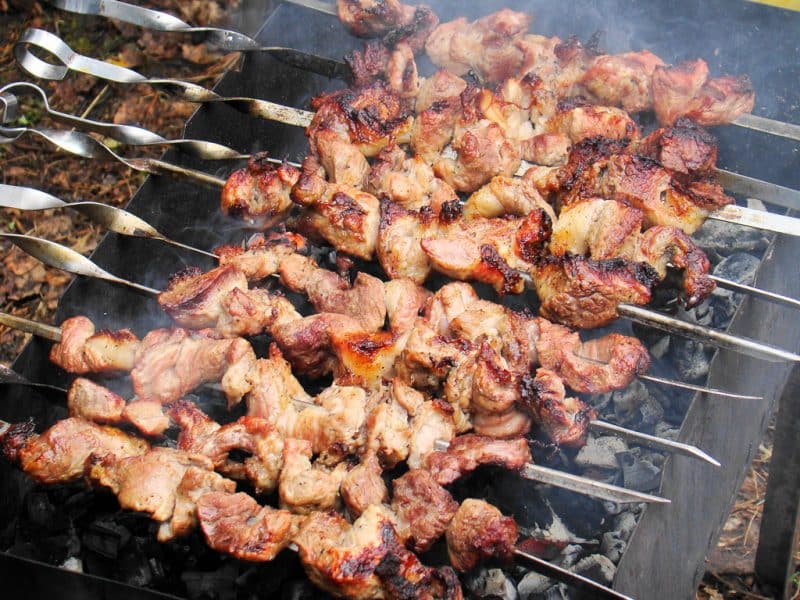
How and When to Eat Shashlyk
(Как правильно есть шашлык?)
Shashlyk is most traditionally made from lamb. The best cuts to use are нога “барана” (leg of lamb), “печень” (liver), and “почка” (kidney). “Говяжья вырезка” (beef tenderloin) and “телятина” (veal) are also considered traditional. However, today shashlyk is most often made from “свинина” (pork), probably because it is naturally “сочная” (juicy) and relatively “недорогая” (inexpensive).
Shashlyk is a national tradition in Russia and its cooks can be as passionate as barbequers in the US.
Shashlyk is occasionally made from more exotic meats such as “птица” (poultry) or “рыба” (fish). To better enhance the flavor, “лук” (onions), “помидоры” (tomatoes), “баклажаны” (eggplants), and/or “грибы” (mushrooms) are sometimes cooked on the skewers with the meat.
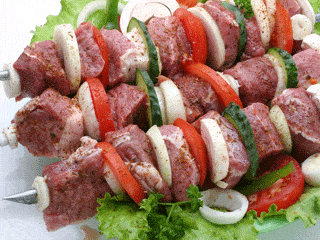
For many people in Russia, shashlyk is not just a dish, but an event. Shashlyk is best prepared and eaten “на улице” (outside) or “на природе” (outdoors, such as when camping) with family and friends and especially on occasions such as birthdays or holidays. It is usually prepared by men who, as a rule, are reluctant to entrust the important process to women. While the shashlyk is being cooked, those gathered talk, joke, and wait for it as the “grand finale.” Usually there is bread and “салаты” (salads) as well, usually prepared by the women. The meal proceeds slowly with toasts and conversation that can last well into the night.
Drinking a lot of alcohol with shashlyk is not recommended; it is best with “немного сухого или полусухого вина” (a little dry or semidry wine) or “немного водки” (a little vodka). “Пиво” (beer) is not recommended by aficionados as it can overpower the taste of the shashlyk. A lot of vodka is also not recommended, as “после этого, никто ничего не чувствует” (after that, nobody feels anything).
How to Prepare Shashlyk
(Как правильно готовить шашлык?)
The meat should be “свежее” (fresh), never “замороженное” (frozen). Ideally, the meat should still be “на кости” (on the bone). “Шейка” (neck meat), “ребра” (ribs), and “корейка” (brisket) are generally good choices.
For beginning Shashlyk makers, try neck meat or “курица“(chicken). Both of these are fairly forgiving, cook quickly and generally stay tender.
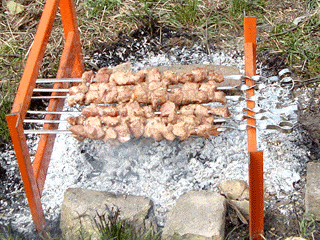
Cut the meat into cubes of about one to two inches. “Мясо нужно мариновать” (the meat needs to be marinated) “от двух часов до суток” (for two to 24 hours).
First, “пересыпать мясо крупной солью” (sprinkle the meat with coarse salt). This will absorb the excess juices and add flavor. Now, “пересыпать крупными размятыми горошками перца” (sprinkle the meat with coarsely ground pepper), and then finally add onion slices. If the meat is fresh, this will suffice for the “маринад” (marinade).
You can also then add almost any “кислые жидкости” (acidic liquids) as additional marinade. “Вино” (wine), “лимонный сок” (lemon juice), “гранатовый сок” (pomegranate juice), and “кислое молоко” (sour milk) are some good choices.
Never marinate in an aluminum pot: the aluminum oxide the meat absorbs from the pot can be toxic.
Shashlyk should be cooked on a fire made from “лиственных пород деревьев” (hardwood). “Виноградные лозы” (grapevines) can also be burned to make excellent shashlyk. Much of the street shashlyk in Russia is cooked over “уголь” (coal – not charcoal), which is also delicious.
There should be no fire under the meat, only white-hot embers. Allow the fire to burn through the fuel, then stir the embers to evenly spread them (and the heat). Now, place the meat above the heat, at a distance of about six inches.
Rotate the skewers frequently, but keep them close together so that the meat traps the smoke underneath.
Let’s Cook!
(Давай приготовим!)
See below for a free recipe for shashlyk. See also the free videos online. If you are interested in cooking from Russia, Ukraine, Georgia, and other places in Eurasia, make sure to see our other resources! You might also be interested in the following specialized cookbooks we’ve enjoyed:
 |
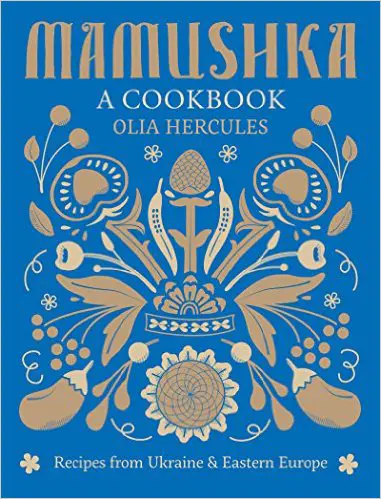 |
 |
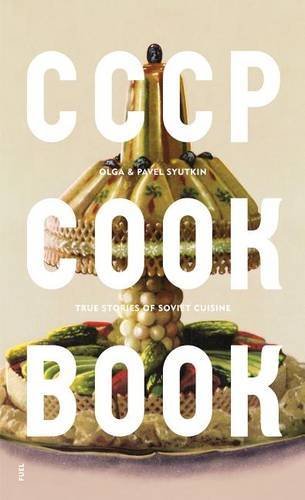 |
| Шашлык классический | Classic Shashlyk |
Ингредиенты
Приготовление
|
Ingredients
Preparation
*tkemali sauce is a traditional sauce from Georgia made with cherry plums, pepper, and spices. If you can’t find any, spicy ketchup can also be used. |
| Шашлык из курицы с острым соусом | Chicken Shashlyk with Spicy Sauce |
Ингредиенты
Приготовление
|
Ingredients
Preparation
*Adjika is a traditional Georgian sauce made with tomatoes, peppers, and spices. If you can’t locate any, try Frank’s Red Hot or a smooth salsa. |
Our Favorite Shashlyk Videos
An excellent way to make shashlyk – from an English-speaking woman from Latvia.
This Persian-style shashlyk goes a bit more exotic on the spices…
Galileo, a Russian popular science show, investigates the science of making good shashlyk.
https://youtube.com/watch?v=EHu_18qnHRY
You Might Also Like
Kupala is an ancient Slavic holiday celebrating the summer solstice, or midsummer. Once part of a series of annual rituals, it marked and was believed to sustain agricultural cycles—essential to early human survival. Held as vitally important, these pagan traditions remained deeply rooted even after Christianization, technological change, and centuries of oppression tried to dislodge […] Easter breads such as kulich, paska, choreg, and nazuki are delicious Easter traditions. Easter is by far the most important religious holiday for those practicing Eastern Christianity. In addition to church services and egg dying, the holiday is also marked across the cultures by ritual bread baking. Despite the wide geographic area covered by Eastern […] Below, Tajik blogger Roxana Burkhanova describes, in Russian, the place of St. Petersburg in Russian culture. She discusses the city’s history as well as its literary heritage, its nightlife, and even how people from Petersburg speak their own, slightly different dialect of Russian. The text was originally written in 2015 and thus references times before […] Rites of welcoming spring and saying goodbye to winter are some of the oldest holidays preserved across Slavic cultures. In the Baltics, the celebrations were nearly lost after being suppressed by Catholic and imperial dominance. Today, Russia’s Maslenitsa is by the far the best-known, but multiple versions exist across the diverse Slavic landscape. In the […] This extensive list of web resources to assist students learning the Russian language was developed by SRAS and is now hosted on Folkways, part of the SRAS Family of Sites! Disclosure: Some of the links below are affiliate links. This means that, at zero cost to you, we will earn an affiliate commission if you […]
Kupala: Ancient Slavic Midsummer Mythology and its Modern Celebration
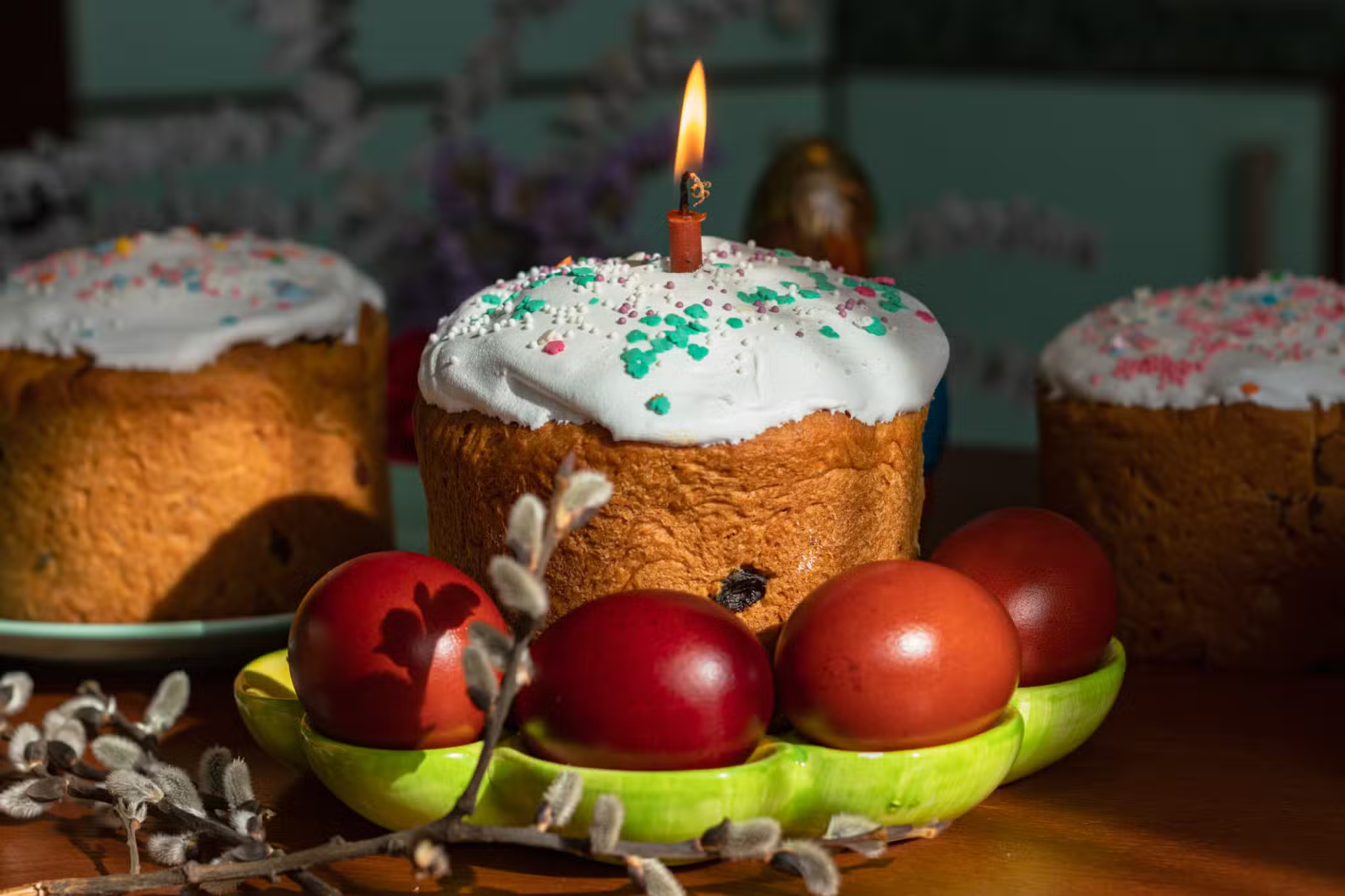
Kulich, Paska, Nazuki: The Easter Breads of Eastern Christianity
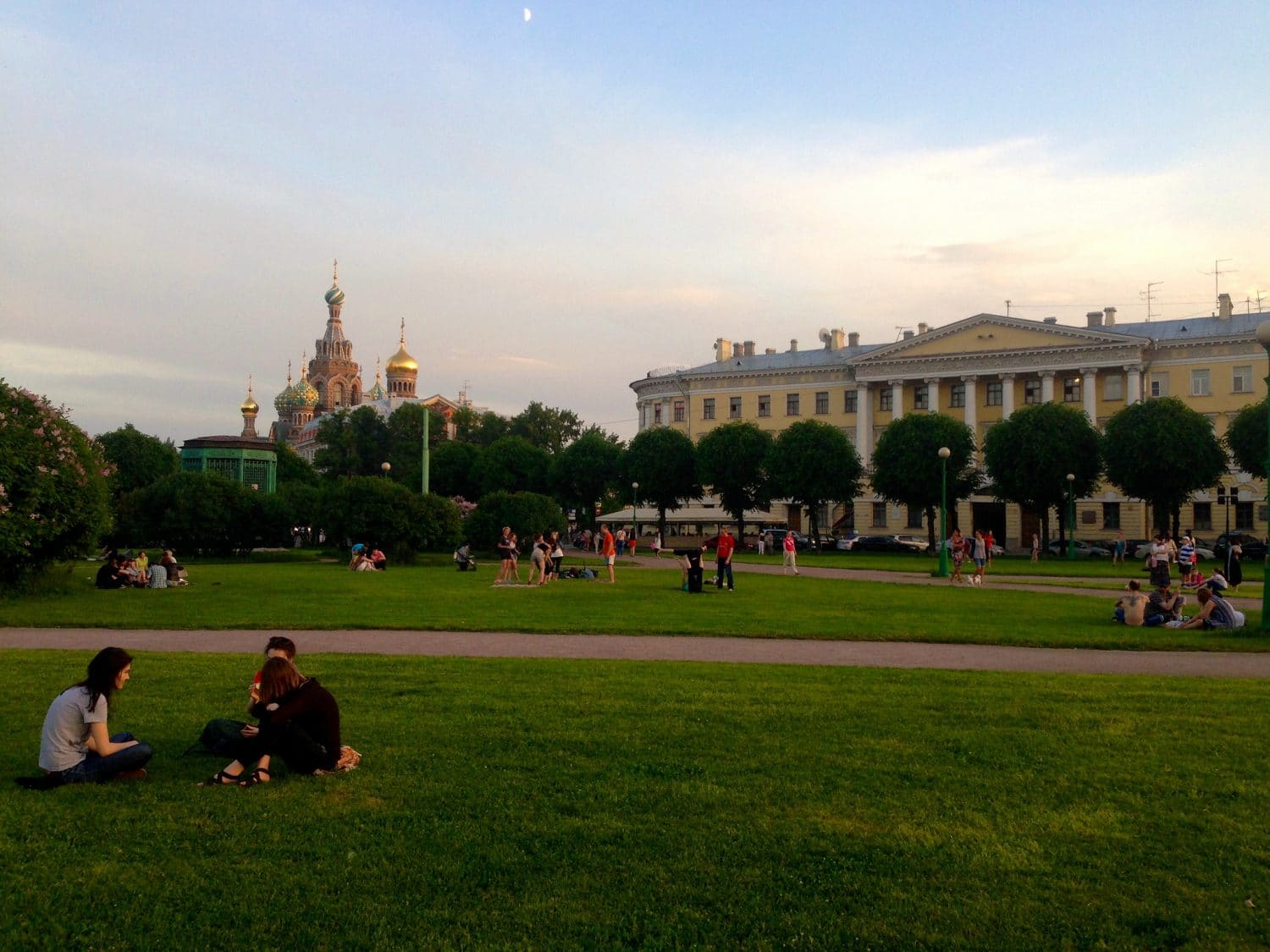
Off to Petersburg, Russia’s Cultural Capital: Моя Россия Blog
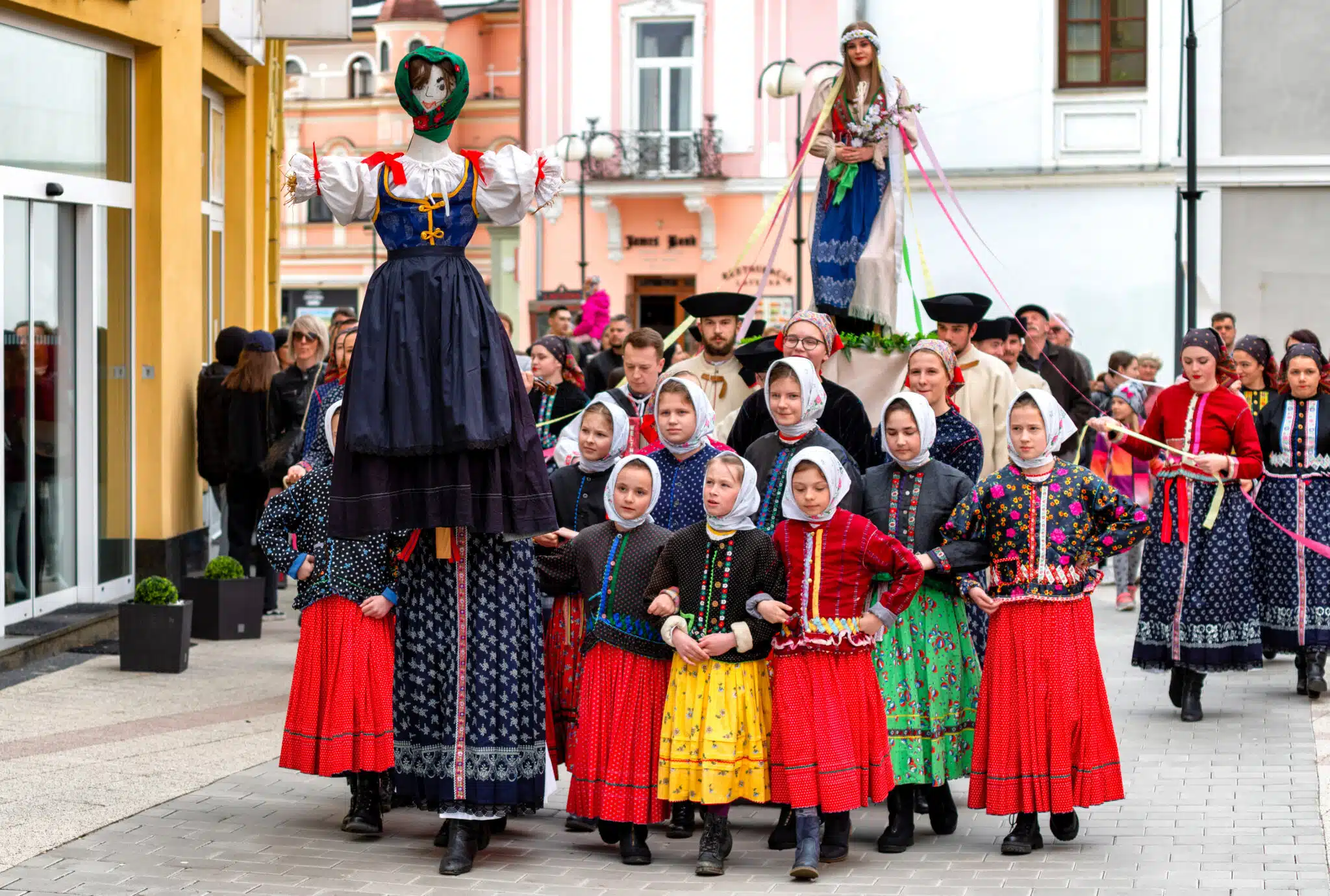
Maslenitsa, Masliana, Meteņi: Spring Holidays of the Slavs and Balts

Resources for Students of Russian

